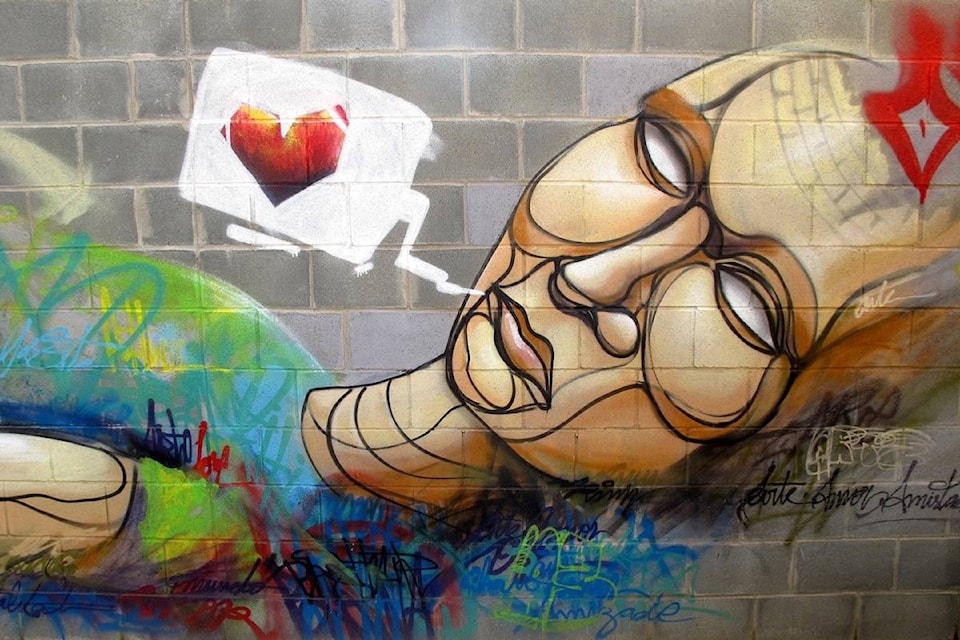When you want a raw look into how regular people are feeling about what’s going on in the world, check out the art on the street, according to artist and former communications professor Marshall Soules.
Perhaps more specifically, check out the street art in Barcelona and Havana — Soules has been documenting the street art (graffiti, posters and all manner of illicit artistic expression) for approximately 30 years.
“It’s kind of an agitated counter-version, another look at another perspective, to see the society, and it’s not whitewashed and it’s spontaneous and it’s messy, but it’s also at times incredibly revealing,” said Soules.
In his exhibit at TOSH (The Old School House Arts Centre, 122 Fern Rd. West, Qualicum Beach), running to Sept. 30, Soules is looking to interpret the photos as a reaction to things like Twitter and other social media, the phenomenon of fake news and conspiracy theories that seem to be fanned by 21st century internet communications.
The approximately 30 images Soules has selected depict mostly faces in a variety of expressions ranging from the hopeful to the fearful, excited to frightened, all of which are valid expressions of the global emotional climate that these forms of internet communication influence.
Soules and B.W. Powe refer to the way in which global communication is networked as the global membrane.
Powe is a Canadian poet, novelist essayist and teacher whose essay, The Charge in the Global Membrane influenced Soules.
Soules’ exhibit is a product of his collaboration with Powe — this year, they’ll be publishing a book through NeoPoiesis Press called The Charge in the Global Membrane, featuring both the essay and Soules’s photos.
The images featured in the exhibit are also some of those featured in the upcoming book.
“(Powe) is writing about using Twitter, the use of social media, phenomenon of fake news, conspiracy theories, they are all happening in the contemporary media,” said Soules.
Soules’s photos are meant to “reflect back on how people feel about the contemporary global communications environment,” he said.
“The question I would ask the people (viewing the exhibit) would be, ‘How are you feeling about these things?’ And some people are going to say ‘I’m really hopeful because now we can network and really come together as a community’ and other people are going to say ‘I’m fed up with all the deceit, the lies, fake news and so forth’ so there’s a range of emotions.”
His photos reflect that, ranging from an image of a peeling C3P0 that looks shocked and uncertain to a woman dreaming of home within a landscape of derelict apartments, and another that looks blissful.
The key reflection on how internet communication is impacting the world is that it’s creating energy.
“The way global communication is kind of networked, that would be the global membrane, the energy is charged and it will go in a positive or a negative direction,” said Soules. “So someone like Trump can push the flow of media electrons, if you like, towards negativity and… isolation and at the same time, there are forces pushing the flow of communication electrons and the feelings that people have about them in positive ways.
Like new developments, enheartening news stories or something that give people hope.”
Soules’s photographs are so descriptive of these reactions because they are the feelings of people on the street.
“My interest in street art was always that it’s a sign of class war in the sense that poor people don’t get to go on the news or get their ideas published in newspapers, so they turn to the streets and that’s where they put up what they’re feeling about what’s going on, and they’re messages, political messages or just cries of despair or wishes for bliss and hope,” said Soules.
“That’s sort of an unofficial version. It’s not the politician’s version, it’s not the economist’s version, it’s the version on the street,” he said.
Some street art, even when randomly created by many people painting and postering over each other, can be incredibly revealing, Soules said. He noted he does not look to take artistic credit for the content of his photos. Other artists created the images, and Soules documents them, he said. The artistry he’s introduced is the technical reproduction of the images, the framing, the selection and the interpretation of them within a theme.
His exhibit continues at TOSH until Sept. 30.
